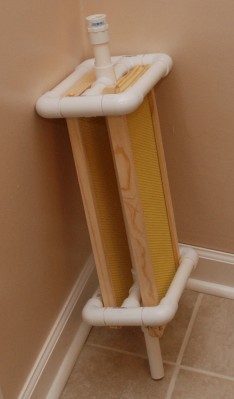There is a lot involved in extracting honey. You have to get the frames into your house without them being covered in bees, there is the removal of capping, the extraction, filtering and bottling. Lots of steps with lots of potential for disaster and hang ups if you are new. We are very new, so I thought a 2 frame mini test extraction would be worth a shot. The girls are busy filling up the empty frames we added a few weeks ago, so we picked two (mostly) ripe frames to test my home built extraction rig.
This is the spinner portion of the centrifuge extractor. I built it to go inside 5 gallon buckets so they would be easier to store. There was an issue though, I didn’t give myself enough room on the bottom set of guides, and it didn’t fit. So I started cutting and modifying and came up with an even better version that requires fewer parts.

While modifying I broke the blade off my PVC cutters =(

Now that I have learned how to properly build the bottom section I will make another and post it with full plans (parts list, lengths to cut, etc.). Until then, just see what the results are from an extractor that cost less than 50 dollars in parts.
The Extraction
We took a set of full frames, de-capped both sides with an electric hot knife, and gave them both a spin. The result was a pretty thorough extraction.
Once the honey settled and went through a filter we got some really amazing biscuits and honey.

One frame was completely packed on both sides. It lost 2lb 10oz going through the spinner. The other was a bit lighter to start with and still had some open cells. That one lost 2lb 1oz in the process. We were able to bottle about 3.5lb of honey and 1oz of wax. There is about a pound missing that probably got lost in the filters and side walls. That will probably happen for extracting 2 frames or 20.
Assuming you do a pile of frames you can expect around 2.5lb of honey per full frame, or 25lb per super. I have 2 supers full, and a 3rd on the way. Oh boy, that is a lot of honey.
Wax Refinement
After letting the cappings drain through the filters for a bit I put them in a tub and did a series of rinses and soaks. After a day of rinse and soak they appeared to be free of honey.

A jelly strainer bag turned out to be perfect for refining. It has a fine mesh on it, and you can toss it when done. Basically dump everything inside, put it in an old pot and set the stove for low. After a while the wax will all melt out and the junk will be left inside.
There will likely be some water in there from all the rinse cycles. No bother, it will separate from the wax naturally. Once you get everything melted, dispose of the bag and pour the pot contents into a form. I used an old yogurt cup.
The hot wax will separate and float to the top. Once cooled, break the wax out. I ended up with a fairly clean chunk of wax weighing just over an ounce. Bees are the best pets ever, thanks girls!!!




























